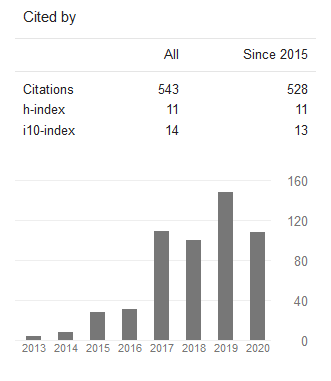Desain Prototipe Sistem Alat Peraga Pendidikan Hologram 3D Portabel dan Interaktif dengan Kendali Gestur Tangan
DOI:
https://doi.org/10.24002/jbi.v13i1.5436Abstract
Abstract. The use of three-dimensional (3D) hologram technology as a learning medium has several challenges to be used in classrooms interactively, portable, and can be seen directly without visual aids for 3D hologram objects. This study designs a prototype of an educational teaching aid system that utilizes 3D Hologram Fan LED display technology and hand gesture sensors to answer the challenges of system design so that it can be used learning medium. The research method includes the stages of technology review, tool design, software development, tool testing, and evaluation of all research stages. The results show that this prototype has a portable design and can be used in an interactive classroom with the average response time of 3D holographic object display on hand gesture control of 1.2 seconds. The 3D hologram object displayed by the prototype of this teaching aid system can be seen directly and clearly at a distance of 0.5 to 7.7 meters.
Keywords: Object 3D Hologram, Hand Gesture, Educational Teaching Aid Prototype, Interactive, Portable.
Abstrak. Pemanfaatan teknologi hologram tiga dimensi (3D) sebagai media pembelajaran memiliki beberapa tantangan agar dapat digunakan di ruang kelas secara interaktif, portabel, dan dapat dilihat secara langsung dengan jelas tanpa alat bantu penglihatan objek hologram 3D. Penelitian ini mendesain prototipe sistem alat peraga pendidikan yang memanfaatkan teknologi penampil Fan LED Hologram 3D dan sensor gestur tangan untuk menjawab tantangan desain sistem agar dapat digunakan sebagai media pembelajaran. Metode penelitian meliputi tahapan kajian teknologi, desain alat, pengembangan perangkat lunak, dan pengujian alat serta evaluasi dari seluruh tahapan penelitian. Hasil penelitian memperlihatkan bahwa prototipe sistem alat peraga
pendidikan memiliki desain yang portabel dan dapat digunakan di ruang kelas secara interaktif dengan waktu tanggap tampilan objek hologran 3D terhadap kendali gestur tangan rata-rata sebesar 1,2 detik. Objek hologram 3D yang ditampilkan oleh prototipe sistem alat peraga ini dapat dilihat secara langsung dengan jelas pada jarak antara 0,5 sampai dengan 7,7 meter.
Kata Kunci: Objek Hologram 3D, Gestur Tangan, Prototipe Alat Peraga Pendidikan, Interaktif, Portabel.
References
R. M. Elsayed and D. H. M. Sajjad, “Designing information by Using the hologram technique in educational signs,” J. Islam. Relig. Stud., vol. 4, no. 1, pp. 11–13, 2019.
R. A. Walker, “Holograms as teaching agents,” J. Phys. Conf. Ser., vol. 415, no. 1, 2013, doi: 10.1088/1742-6596/415/1/012076.
F. Salvetti and B. Bertagni, “Interactive Tutorials and Live Holograms in Continuing Medical Education : Case Studies from the e-REAL ® Experience,” in The International Conference on E-Learning in the Workplace 2016, 2016, pp. 1–8.
N. M. M. Barkhaya and N. D. A. Halim, “A review of application of 3D hologram in education: A metaanalysis,” 2016 IEEE 8th Int. Conf. Eng. Educ. Enhancing Eng. Educ. Through Acad. Collab. ICEED 2016, pp. 257–260, 2017, doi: 10.1109/ICEED.2016.7856083.
I. Tawaqqal, I. Purwanti Ningrum, and M. Yamin, “Hologram holographic pyramid 3 dimensi,” semanTIK, vol. 3, no. 1, pp. 181–188, 2017, [Online]. Available: http://ojs.uho.ac.id/index.php/semantik/article/view/3288
A. H. Awad and F. F. Kharbat, “The first design of a smart hologram for teaching,” 2018 Adv. Sci. Eng. Technol. Int. Conf. ASET 2018, pp. 1–4, 2018, doi: 10.1109/ICASET.2018.8376931.
U. Sudeep, “Use of 3D Hologram Technology in Engineering Education,” SICETE. [Online]. Available: www.iosrjournals.org
L. N. Hoon and S. S. Shaharuddin, “Learning Effectiveness of 3D Hologram Animation on Primary School Learners,” J. Vis. Art Des., vol. 11, no. 2, pp. 93–104, Dec. 2019, doi: 10.5614/j.vad.2019.11.2.2.
D. Mavrikios, K. Alexopoulos, K. Georgoulias, S. Makris, G. Michalos, and G. Chryssolouris, “Using Holograms for visualizing and interacting with educational content in a Teaching Factory,” in Procedia Manufacturing, 2019, vol. 31, pp. 404–410. doi: 10.1016/j.promfg.2019.03.063.
E. Hu Au and J. J. Lee, “Virtual reality in education: a tool for learning in the experience age,” Int. J. Innov. Educ., vol. 4, no. 4, p. 215, 2017, doi: 10.1504/ijiie.2017.10012691.
C. Wyss, W. Bührer, F. Furrer, A. Degonda, and J. A. Hiss, “Innovative teacher education with the augmented reality device microsoft hololens—results of an exploratory study and pedagogical considerations,” Multimodal Technol. Interact., vol. 5, no. 8, Aug. 2021, doi: 10.3390/mti5080045.
M. X. Prado Ortega, J. C. Delgado Ramírez, J. W. Valarezo Castro, J. L. Armijos Carrión, A. A. Ávila Carvajal, and A. N. González Segarra, “Application of the technical - pedagogical resource 3D holographic LED-fan display in the classroom,” Smart Learn. Environ., vol. 7, no. 1, Dec. 2020, doi: 10.1186/s40561-020-00136-5.
M. J. Hidayat, “Kajian Desain Alat Peraga Pendidikan Untuk Siswa Playgroup,” in Proceeding Seminar Kajian Budaya Visual, 2008, no. August 2008, p. 74.
F. T. Nomleni and T. S. N. Manu, “Pengembangan Media Audio Visual dan Alat Peraga dalam Meningkatkan Pemahaman Konsep dan Pemecahan Masalah,” Sch. J. Pendidik. dan Kebud., vol. 8, no. 3, pp. 219–230, 2018, doi: 10.24246/j.js.2018.v8.i3.p219-230.
Yunita Wildaniati; Adesia Afriana, “Penggunaan Alat Peraga untuk Meningkatkan Hasil Belajar Siswa Kelas V SD N 2 Gunung Katun Kecamatan Baradatu,” Dewantara, vol. VII, pp. 56–72, 2019.
G. Matteucci, “Holography: origin, basic principle and applications of a revolutionary communication method in art and science,” Rev. la Acad. Colomb. Ciencias Exactas, Físicas y Nat., vol. 39, no. 0, p. 11, 2015, doi: 10.18257/raccefyn.251.
C. Slinger, C. Cameron, and M. Stanley, “Computer-generated holography as a generic display technology,” Computer (Long. Beach. Calif)., vol. 38, no. 8, pp. 46–53, 2005, doi: 10.1109/MC.2005.260.
F. Yaraş, H. Kang, and L. Onural, “State of the art in holographic displays: A survey,” IEEE/OSA J. Disp. Technol., vol. 6, no. 10, pp. 443–454, 2010, doi: 10.1109/JDT.2010.2045734.
L. Vokorokos, “Leap Motion , Myo Armband and Kinect v2 Low-Cost Motion Sensors in the Internet of Things , Controlled by Raspberry Pi 3 and Arduino UNO,” Int. J. Innov. Sci. Res. Technol., vol. 3, no. 7, pp. 733–737, 2018.
L. Orcos, C. Jordán, and A. Magreñán, “3D visualization through the hologram for the learning of area and volume concepts,” Mathematics, vol. 7, no. 3, pp. 1–20, 2019, doi: 10.3390/math7030247.
M. Araiza-Esquivel, P. C. Godina, A. López-Martínez, C. Olvera, S. V. Barraza, and D. Ortiz-Daz, “Teaching digital holography through an interface in Java,” Opt. InfoBase Conf. Pap., vol. Part F130-, no. July 2019, 2019, doi: 10.1117/12.2520784.
L. Lindstrom and R. Jeffries, “Extreme programming and agile software development methodologies,” Inf. Syst. Manag., vol. 21, no. 3, pp. 41–52, 2004, doi: 10.1201/1078/44432.21.3.20040601/82476.7.
R. Fojtik, “Extreme programming in development of specific software,” Procedia Comput. Sci., vol. 3, pp. 1464–1468, 2011, doi: 10.1016/j.procs.2011.01.032.
Z. Zhang, “Microsoft kinect sensor and its effect,” IEEE Multimedia, vol. 19, no. 2. pp. 4–10, 2012. doi: 10.1109/MMUL.2012.24.
I. U. Rehman, S. Ullah, D. Khan, S. Khalid, A. Alam, G. Jabeen, I. Rabbi, H. U. Rahman, N. Ali, M. Azher, S. Nabi, and S. Khan, “Fingertip gestures recognition using leap motion and camera for interaction with virtual environment,” Electron., vol. 9, no. 12, pp. 1–20, Nov. 2020, doi: 10.3390/electronics9121986.
Rawat Seema, Vats Somya, and Kumar Praveen, “Evaluating and Exploring the MYO ARMBAND,” in Proceedings of the SMART-2016 : 5th International Conference on System Modeling & Advancement in Research Trends., 2016, pp. 115–120.
S. Yamada, T. Kakue, T. Shimobaba, and T. Ito, “Interactive Holographic Display Based on Finger Gestures,” Sci. Rep., vol. 8, no. 1, pp. 1–7, 2018, doi: 10.1038/s41598-018-20454-6.
M. Araiza-Esquivel, P. C. Godina, A. López-Martínez, C. Olvera, S. V. Barraza, and D. Ortiz-Daz, “Teaching digital holography through an interface in Java,” in Optics InfoBase Conference Papers, 2019, vol. Part F130-ETOP 2019. doi: 10.1117/12.2520784.
Downloads
Published
Issue
Section
License
Copyright (c) 2022 Jurnal Buana Informatika

This work is licensed under a Creative Commons Attribution-ShareAlike 4.0 International License.
Copyright of this journal is assigned to Jurnal Buana Informatika as the journal publisher by the knowledge of author, whilst the moral right of the publication belongs to author. Every printed and electronic publications are open access for educational purposes, research, and library. The editorial board is not responsible for copyright violation to the other than them aims mentioned before. The reproduction of any part of this journal (printed or online) will be allowed only with a written permission from Jurnal Buana Informatika.
This work is licensed under a Creative Commons Attribution-ShareAlike 4.0 International License.










